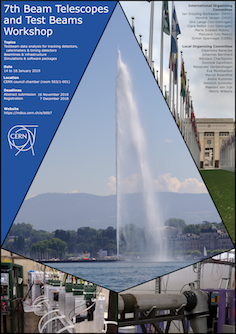Speakers
Description
The high luminosity upgrade of the LHC will lead to an increased multiplicity of proton-proton interactions, with up to 200 events per beam bunch crossing, in the CMS experiment.
The irradiation level that the detectors will have to withstand will reach a 1MeV neutron equivalent fluence of 2 $\times$ 10$^{16}$ n$_{eq}$/cm$^2$ at the innermost part of the CMS pixel detector, at 2.8 cm distance from the beam axis.
To build a pixel detector with good performance under these conditions, planar pixel sensors are so far considered only for the pixel barrel layers 2-4, where the irradiation level will reach a 1 MeV neutron equivalent fluence of 5 $\times$ 10$^{15}$ n$_{eq}$/cm$^2$, as the limit of their radiation hardness is still under investigation.
Several variants of new n+p, planar pixel sensors with pixel sizes of 50 $\times$ 50 $\mu$m$^2$ and 100 $\times$ 25 $\mu$m$^2$ and an active thickness of 150 $\mu$m have been designed and bump bonded to ROC4SENS read-out chips. Apart from the pixel size, the design variants differ with respect to the implantation and metalization geometry as well as the pixel isolation and biasing scheme.
To select the most promising design for the future CMS pixel detector, 18 weeks of beam test with a campaign of measurements on more than 50 sensors, non-irradiated and irradiated up to 1 MeV neutron equivalent fluences of 4 $\times$ 10$^{15}$ n$_{eq}$/cm$^2$, have been completed at the DESY test beam facility.
The measurements were performed using the DATURA beam telescope for tracking and a CMS Phase 1 reference module for timing.
The edge-on method is used to measure the depletion depth and possibly trapping effects due to irradiation as the track passes the pixel cells at varying depths. In this talk, efficiency and edge-on measurements are shown as a function of the applied bias voltage, for irradiated and non-irradiated sensors.
